U-211: Fighting for vitality, half a century long. Part II. Memory
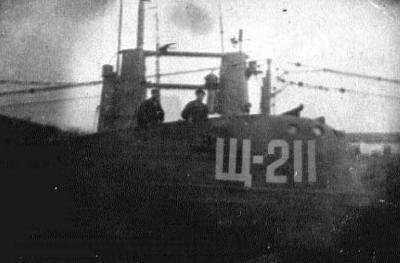 In the 90-ies, on the wave of anti-Soviet and anti-communist sentiments throughout Eastern Europe, a formidable Russophobic campaign was launched. Bulgaria turned out to be one of the very few countries where healthy Slavic, Orthodox feelings took over fratricidal slander. There have been attempts to demolish Monument to the Soviet Soldier-Liberator in Plovdiv (Alyosha), Monument to the Soviet Army in Sofia and many others. Fortunately, most of these attempts did not succeed. Normal residents of the country were organized events in the protection of monuments. In the most difficult days, the defenders lived around the clock in tents near the monuments to prevent their demolition. Dozens of statues, busts and bas-reliefs of the socialist era were dismantled from pedestals, but they were not lost. At these times, a ton of bronze cost about $ 3.500, and the minimum wage in Bulgaria was less than $ 100. However, the monuments were not melted down. They were carefully preserved for over 20 years, until they were collected in Museum of Socialist Art in Sofia in 2011 year.
In the 90-ies, on the wave of anti-Soviet and anti-communist sentiments throughout Eastern Europe, a formidable Russophobic campaign was launched. Bulgaria turned out to be one of the very few countries where healthy Slavic, Orthodox feelings took over fratricidal slander. There have been attempts to demolish Monument to the Soviet Soldier-Liberator in Plovdiv (Alyosha), Monument to the Soviet Army in Sofia and many others. Fortunately, most of these attempts did not succeed. Normal residents of the country were organized events in the protection of monuments. In the most difficult days, the defenders lived around the clock in tents near the monuments to prevent their demolition. Dozens of statues, busts and bas-reliefs of the socialist era were dismantled from pedestals, but they were not lost. At these times, a ton of bronze cost about $ 3.500, and the minimum wage in Bulgaria was less than $ 100. However, the monuments were not melted down. They were carefully preserved for over 20 years, until they were collected in Museum of Socialist Art in Sofia in 2011 year.Despite the general success in the protection of monuments, as in any war, this also did not go without some tactical failures on certain sections of the ideological front. Such a single tactical loss turned out to be a bronze slab with the name of the commander "Shch-211" Alexander Devyatko. Captain Lieutenant is doubly unlucky. Firstly, he was not a Russian at all, but a Soviet officer, which especially infuriated Democrats and Liberasts of all stripes. By the way, Devyatko was a Ukrainian, but since he wore a Soviet officer's uniform, few people were already worried about such details. Secondly, its memorial plate stood on one of the main streets of Varna. It was and remains the "sea capital" of Bulgaria. Highways, sea and railway stations and the airport converge here. Here are the most expensive hotels and restaurants where princes from the outskirts of the liberal western world regularly come to show off their position. Each time they passed along this street, a modest memorial plate of a junior officer, which died near Varna, flickered in front of them to defend the city at Kriegsmarine.
Our native Bulgarian reptiles is still nothing, they would have endured. But in the “sea capital” every day, high-ranking officials come from the super-democratic and super-liberal West. Every time it asked what kind of a memorial plaque. Hearing that this is a Soviet officer who sank at least two Hitler’s allied ships near Varna, the liberals (“freedom-lovers”) and humanists (“lovers of humanity”) from the democratic and tolerant (“tolerant”) West frowned like an unbearable toothache. Someone had to get off this street, and in 1993, the Democrats and Liberast won a small Pyrrhic victory. The modest memorial slab of Alexander Devyatko was demolished and carried away in an unknown direction. The plate was demolished, but the street was not renamed. After all, for such a people would rebel, and the managers would not have seemed little. And the stove was there and it flooded. Who knows what floated in those turbid times. Once the metropolitan government decided to repair several streets. The tram rails were taken out of the old streets, the new asphalt was laid, and when they decided to re-install the rails, it turned out that they had already gone. Several kilometers of a double-track tramline, dozens of tons of rails disappeared. And in Varna - just a plate of bronze meter and a half, with a finger in thickness. It seems even the city government has nothing to do with it.
So Alexander Devyatko Street was left without Alexander Devyatko. 50 years after the end of the Great Patriotic War, the enemy again broke through to the west coast of the Black Sea and first of all began to sink Soviet submarines. This time not theirs, but the memory of them. "U-211" was no stranger to fight one with a mighty enemy at a great distance from their home bases and covering forces. She did not leave the battlefield, but only lurked for a decade, waiting for better times. She lived in the hearts of those who remembered her and loved her.
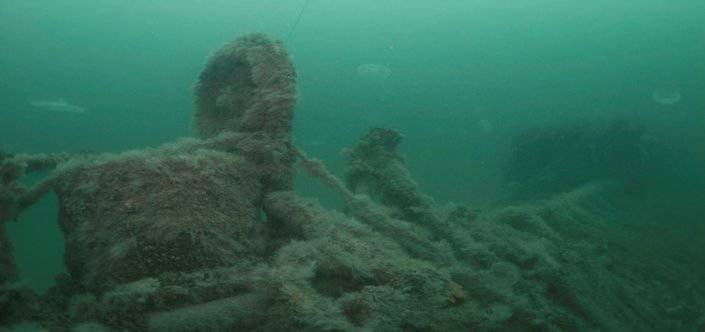
On September 11, 2000, Bulgarian divers Dinko Mateev and Vladimir Stefanov found the remains of an unknown Soviet submarine while catching rapans. Since in this area of the Black Sea in 1941-1942. several submarines were killed at once, the Bulgarian authorities were in no hurry to report the find, because the possibility of re-discovering an already known unit was not ruled out. In August 2001, the fourth historical and ethnographic expedition “Walking Over Three Seas”, launched with the support of the Naval, started in Sevastopol from Grafskaya Marina fleet RF, the government of the Russian capital and the international organization of UNESCO. Its participants were seven schoolchildren from Moscow and Sevastopol, who won this honorary right according to the results of the scientific conference "Archipelago expeditions of the Russian fleet." Returning to Sevastopol, the guys reported an unusual find to the command of the Russian Black Sea Fleet. A corresponding request was sent to the General Staff of the Bulgarian Navy. The answer did not come right away: to say something specific about the submarine lying at the bottom, it was required not only its external examination with the help of divers, but also serious work with archival documents. Former senior diver of the naval base "Varna", cap. Retired 3rd rank Rosen Gevshekov organized a team of scuba divers, which included members of the local diving club Relikt-2002. It was found that there really lies a Soviet submarine of the time of the Great Patriotic War of the type "Щ", similar to the submarine "Щ-204", discovered in 1983 20 miles from Varna.
1 July 2003 of the year from Sevastopol to the shores of Bulgaria went an expedition from the rescue ship "EPRON" and the KIL-158 vessel of the Black Sea Fleet of Russia. They had to examine and identify the “Pike” that had died in the Varna Bay area. Russians in Bulgaria were welcomed cordially. According to the spokesperson of the press service of the Black Sea Fleet, captain 2 of the rank of Nikolay Voskresensky, the Bulgarian naval “despite the NATO orientation, it was very difficult to pretend that today nothing binds Russia and Bulgaria. There is still a lot left from Soviet times: warships, badges with stars on sailors' belts, cars, music and television channels. You can often hear the Russian language, although, to be frank, the current Bulgarian youth more often prefer English. ”
The expedition found a submarine on the evening of July 4 of the year 2003. It quickly became clear that the “Pike” had died very quickly, if not immediately. The submarine hull was broken into two unequal parts. More massive - aft, lay course 60 degrees with a roll of 5 degrees on the left side and a trim 10 degrees on the nose. The bow section was buried in the ground at 5 meters. The boat was heavily overgrown with shell, the layer reached 20 in some places, see. The submarine hull was covered with silt on 40 cm. Fencing solid logging completely absent. The access hatches in the 4 and 7 compartments were open, and the upper hatch of the log hatch was also missing.
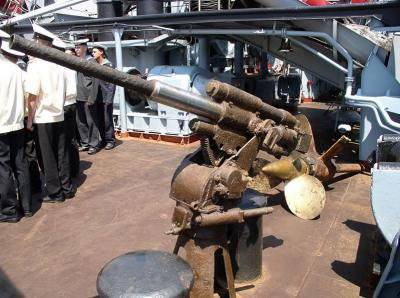
A total of 35 descents were made to the boat, with a total duration of more than 50 hours. Several fragments of boat mechanisms, a Soviet helmet, a compass kettle completely unharmed, pieces of railings and insulation — all 28 items — were lifted to the surface. The best trophy, of course, was the 45-mm nasal gun. To the surprise of the divers, after 62 years of being under water, 21 from the 24's gun mounts surrendered in normal mode. After cleaning, many mechanisms of sorokapyatki turned out to be valid. This is probably the best Russian advertisement. arms. A barely distinguishable factory number — 2162 No. and the inscription “1939 Year” were found on the chipped metal of the cannon lock. They found a serial number on the carriage, a wrench was kept in a regular place. The greatest success was the discovery of a fragment of a metal plate with the emblem of the Soviet Union. The symbol of a great country that no longer exists was raised from a submarine that perished for its independence. The plate as the most valuable passed from hand to hand. The last, on the submarine killed by the enemy, divers dismantled the left three-blade propeller with brackets.
Today, with a great degree of certainty, it is known that in the coordinates W = 43 ° 06 ', 8 sowing latitude and D = 28 ° 07 ', 5 East longitude at the bottom of the Black Sea lies the lost Soviet submarine Shch-211. This point, in accordance with international rules, was declared the 44 mass grave of Soviet submariners and the coordinates of the military glory of the Russian Black Sea Fleet.
At a press conference in the port of Varna, the head of the UPASR Black Sea Fleet Captain 1st Rank Vasily Vasilchuk announced the main version of the death of the submarine. It is based on material accumulated by the expedition. Shch-211 was discovered by the Romanian mine trap Prince Karol, following the course to Varna. In the opinion of V. Vasilchuk, the first torpedo attack on the Romanian mine layer by the "Pike" failed for some reason. Romanian sailors managed to transmit a danger signal to the shore. This did not help the mine layer. The second salvo from the "Pike" still sent to the bottom of the Romanian aristocrat. This was the last victory of the Shch-211. The Hitlerites were well acquainted with the positions in which Soviet submarines carried combat patrols. Finding a defenseless Pike in shallow water was easy. From coastal airfields raised Aviation. Aircraft, presumably the Junkers, dropped in to attack from the side of the sun. "Щ-211" was in the surface position, in which the speed of the boat is much higher. The submarine was torn to 50-meter depths, where it was possible to hide under water. Diesel rumbled mercilessly and the noise of aircraft engines in a submarine did not hear, as they did not notice the aircraft themselves. The "Pike" was first fired from heavy machine guns. Traces of bullets are now clearly visible on the body. Then bombs flew onto the boat. One of them fell into a light housing in the area of the first and second compartments. An explosion occurred, as a result of which the ammunition was detonated, and weak intersection bulkheads were demolished. The nose of the "Pike" was simply torn off, and it itself went to the bottom with a stone, buried in the ground for several meters. It is well known that the structural disadvantage of the boats of this series was poor longitudinal stability. This largely explains the rapid death of the boat. Presumably after the flooding of the submarine, the place where they discovered the oil slick was bombarded by depth charges from German ships.
In Varna, Russian military ships were greeted warmly. As a sign of respect for Russian sailors, the national flag of the Russian Federation was raised on the building of the Naval Station. The Consul General of the Russian Federation in Varna, A. Dzharimov and representatives of the Bulgarian Navy Command arrived on board the EPRON. Many Bulgarians came to the city cemetery in Varna, as a sign of respect for the ceremony of laying a wreath and flowers by Russian sailors to the monuments to the fallen Soviet and Bulgarian soldiers. To the sounds of the orchestra, flowers were laid at the foot of the obelisk, and the orchestra consistently played the anthems of the two countries.
In 2010, the Commission on Culture at the Varna City Council made a formal decision on the return of the pape bastard. leith Alexander Devyatko and erection of his monument near the Black Sea. Like every administration in the world, the Bulgarian have no hurry either. For the third year in a row, they are looking for where the memorable roach disappeared (most likely it was melted down two decades ago). They make plans and schedules, write reports ... The fact that there is still no monument is not a problem for the administration. If it’s necessary, they will write a report about why the monument has not yet been erected, will bring an apology and their deep personal human regret, then make new plans and schedules ... I was angered, but what's the point? Perhaps, someday, they will!
What is important for us is that Schuka won the battle again, this time not at sea, but in the ideological field of the military stories. “U-211” in Bulgaria know, remember and love. She - the most famous submarine in the military history of Bulgaria. The gun removed from it in 2003 is now in the Military History Museum of the Russian Black Sea Fleet in Sevastopol, and other artifacts are in the Central Naval Museum in St. Petersburg.
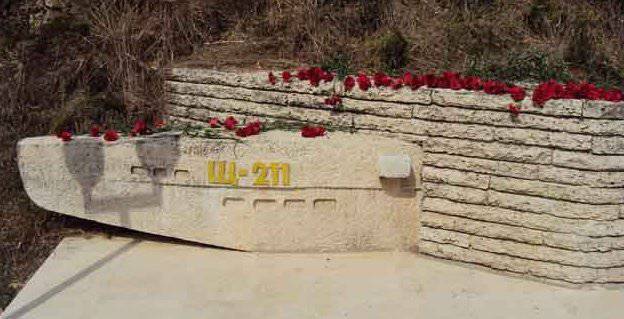
Monument "Shch-211" near the mouth of the river Kamchiya, where 11 August 1941
landed 14 Bulgarian saboteurs under the command of Tsvyatko Radoinova
In the 90's, the Democrats did not get to it.
In 2010, Bulgaria was visited by a group of 30 veterans from the Black Sea Fleet of the USSR from Russia and Ukraine. Chairman of the Ukrainian Association of Submariner Veterans Retired 1 Alexander Vladimirovich Kuzmin awarded the Mayor of Varna a commemorative medal. Soviet veterans and official representatives of the Bulgarian authorities went on a boat to the place of the death of Shch-211. A requiem prayer was served, the wreaths solemnly lowered into the waves.
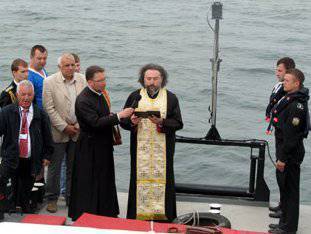
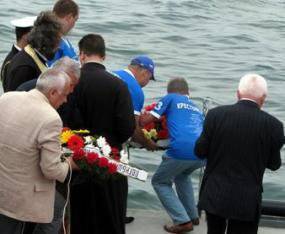
TTD "Shch-211"
Soviet diesel electric submarine of type "Sh", series "X".
Displacement (surface / underwater): 586 / 708 t.
Dimensions: length - 58,8 m, width - 6,2 m, draft - 4,0 m.
Travel speed (surface / submarine): 14,1 / 8,5 nodes.
Navigation range: over water 4500 miles 8,5 nodes, under water 100 miles with 2,5 nodes.
Powerplant: 2 x 800 hp diesel, 2 x 400 hp electric motor.
Armament: 4 bow and 2 stern 533-mm torpedo tubes (10 torpedoes), 2 45-mm 21-K guns (1000 shots), air defense - a machine gun.
Immersion depth: working - 75 m, limit - 90 m.
Crew: 40 people.
The list of those who died on “U-211” in November 1941:
1. Devyatko, Alexander Danilovich, r. 1908, submarine commander, cap. lt
2. Samoilenko, Ivan Evdokimovich, r. 1912, Commissar, Art. political instructor
3. Borisenko, Pavel Romanovich, r. 19091 Assistant Commander, Art. lt
4. Korablev, Victor Alexandrovich, r. 1913, Commander CW-1, Art. lt
5. Mironov, Vasily Ignatievich, p. 1915, Commander CW-3, lt
6. Reed, Alexey Ivanovich, r. 1907, Commander CU-5, voenteh. Xnumx rank
7. Sergeychuk, Savveliy Demyanovich, r. 1917, beg. sanitary service, voyenfeld.
8. Baltaxa, Yuri Arnoldovich, p. 1918, understudy commander CU-3, lt
9. Shumkov, Georgiy Grigorievich, p. 1913 understudy commander CU-5, voenteh. Xnumx rank
10. Dubovenko, Theodore Filippovich, p. 1913, foreman c. helmsman, ch. Art.
11. Shaparenko, Alexey Dmitrievich, p. 1914, Commander Dep. helmsmen, art. 2 Art.
12. Toporikov, Mikhail Ivanovich, p. 1918, senior helmsman, art. sailor
13. Sapiy, Ivan Timofeevich, r. 1920, steering, sailor
14. Gavrilov, Alexey Ivanovich, p. 1921, Commander Dep. gunners, art. 2 Art.
15. Yemelyanov, Petr Petrovich, r. 1917, Commander Dep. NNP, Art. 2 Art.
16. Yarema, Andrei Fedorovich, r. 1916, steering, sailor
17. Molchan, Vitaly Alexandrovich, r. 1921, Commander Dep. gunners, art. 2 Art.
18. Kvetkin, Peter Sergeevich, r. 1913, foreman c. hold, ch. Art.
19. Baranov, Alexey Alexandrovich, r. 1921, Commander Dep. gunners, art. 2 Art.
20. Danilin, Nikolai Vasilievich, p. 1920, senior torpedo player, art. sailor
21. Ryabinin, Fedor Andreevich, p. 1920, torpedo player, sailor
22. Sotnikov, Pavel Mikhailovich, p. 1915, foreman c. radio operators, art. 1 Art.
23. Khokhlov, Vladimir Sergeevich, r. 1917, Commander Dep. radio operators, art. 2 Art.
24. Logoshin, Peter Nikolaevich, r. 1919, radio operator, sailor
25. Rozanov, Vladimir Nikolaevich, r. 1911, foreman c. motorists, midshipman
26. Puzikov, Ivan Filippovich, r. 1917, Commander Dep. motorists, art. 2 Art.
27. Selidi, Grigory Kharlamovich, r. 1915, Senior Minder, Art. sailor
28. Sorokin, Victor Pavlovich, r. 1918, Senior Minder, Art. sailor
29. Fourko, Vasily Pavlovich, p. 1917, minder, sailor
30. Bukatov, Vladimir Vladimirovich, r. 1918, minder, sailor
31. Kryuchkov, Sergey Ignatievich, p. 1915, foreman c. electricians, art. 1 Art.
32. Chumak, Andrey Yakovlevich, r. 1914, Senior Electrician, Art. sailor
33. Konovalenko, Boris Artyomovich, r. 1918, electrician, sailor
34. Kutar, Nikolai Ivanovich, p. 1920, electrician, sailor
35. Mezin, Spiridon Fedoseyevich, r. 1911, foreman c. hold, ch. Art.
36. Kravchenko, Vladimir Pavlovich, r. 1916, Commander Dep. hold, art. 2 Art.
37. Gauzer, Grigory Alexandrovich, r. 1918, Hold, Red Navy
38. Kurkov, Vladimir Mikhailovich, r. 1915, Commander Dep. electricians, art. 2 Art.
39. Mochalov, Boris Yakovlevich, r. 1921, Hold, Red Navy
40. Lifenko, Andrei Mikhailovich, p. 1919, Hold, Red Navy
41. Ivashin, Alexander Nikiforovich, p. 1922, Commander Dep. SKS, sailor
42. Sypachev, Tikhon Pavlovich, r. 1917, cook, sailor
43. Plekhov, Konstantin Mironovich, r. 1920, drill, sailor
44. Cargo, Victor Nikolaevich, p. 1920, electrician, sailor
Information